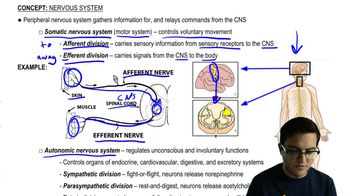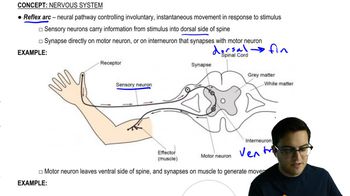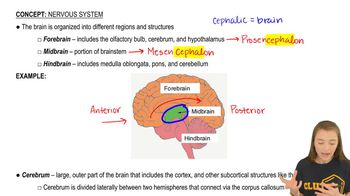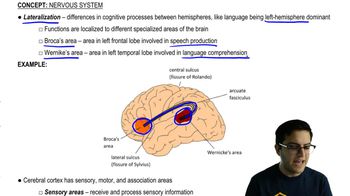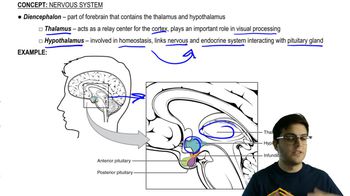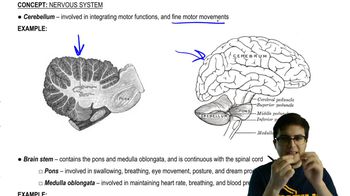Table of contents
- 1. Introduction to Biology2h 42m
- 2. Chemistry3h 40m
- 3. Water1h 26m
- 4. Biomolecules2h 23m
- 5. Cell Components2h 26m
- 6. The Membrane2h 31m
- 7. Energy and Metabolism2h 0m
- 8. Respiration2h 40m
- 9. Photosynthesis2h 49m
- 10. Cell Signaling59m
- 11. Cell Division2h 47m
- 12. Meiosis2h 0m
- 13. Mendelian Genetics4h 44m
- Introduction to Mendel's Experiments7m
- Genotype vs. Phenotype17m
- Punnett Squares13m
- Mendel's Experiments26m
- Mendel's Laws18m
- Monohybrid Crosses19m
- Test Crosses14m
- Dihybrid Crosses20m
- Punnett Square Probability26m
- Incomplete Dominance vs. Codominance20m
- Epistasis7m
- Non-Mendelian Genetics12m
- Pedigrees6m
- Autosomal Inheritance21m
- Sex-Linked Inheritance43m
- X-Inactivation9m
- 14. DNA Synthesis2h 27m
- 15. Gene Expression3h 20m
- 16. Regulation of Expression3h 31m
- Introduction to Regulation of Gene Expression13m
- Prokaryotic Gene Regulation via Operons27m
- The Lac Operon21m
- Glucose's Impact on Lac Operon25m
- The Trp Operon20m
- Review of the Lac Operon & Trp Operon11m
- Introduction to Eukaryotic Gene Regulation9m
- Eukaryotic Chromatin Modifications16m
- Eukaryotic Transcriptional Control22m
- Eukaryotic Post-Transcriptional Regulation28m
- Eukaryotic Post-Translational Regulation13m
- 17. Viruses37m
- 18. Biotechnology2h 58m
- 19. Genomics17m
- 20. Development1h 5m
- 21. Evolution3h 1m
- 22. Evolution of Populations3h 52m
- 23. Speciation1h 37m
- 24. History of Life on Earth2h 6m
- 25. Phylogeny2h 31m
- 26. Prokaryotes4h 59m
- 27. Protists1h 12m
- 28. Plants1h 22m
- 29. Fungi36m
- 30. Overview of Animals34m
- 31. Invertebrates1h 2m
- 32. Vertebrates50m
- 33. Plant Anatomy1h 3m
- 34. Vascular Plant Transport1h 2m
- 35. Soil37m
- 36. Plant Reproduction47m
- 37. Plant Sensation and Response1h 9m
- 38. Animal Form and Function1h 19m
- 39. Digestive System1h 10m
- 40. Circulatory System1h 57m
- 41. Immune System1h 12m
- 42. Osmoregulation and Excretion50m
- 43. Endocrine System1h 4m
- 44. Animal Reproduction1h 2m
- 45. Nervous System1h 55m
- 46. Sensory Systems46m
- 47. Muscle Systems23m
- 48. Ecology3h 11m
- Introduction to Ecology20m
- Biogeography14m
- Earth's Climate Patterns50m
- Introduction to Terrestrial Biomes10m
- Terrestrial Biomes: Near Equator13m
- Terrestrial Biomes: Temperate Regions10m
- Terrestrial Biomes: Northern Regions15m
- Introduction to Aquatic Biomes27m
- Freshwater Aquatic Biomes14m
- Marine Aquatic Biomes13m
- 49. Animal Behavior28m
- 50. Population Ecology3h 41m
- Introduction to Population Ecology28m
- Population Sampling Methods23m
- Life History12m
- Population Demography17m
- Factors Limiting Population Growth14m
- Introduction to Population Growth Models22m
- Linear Population Growth6m
- Exponential Population Growth29m
- Logistic Population Growth32m
- r/K Selection10m
- The Human Population22m
- 51. Community Ecology2h 46m
- Introduction to Community Ecology2m
- Introduction to Community Interactions9m
- Community Interactions: Competition (-/-)38m
- Community Interactions: Exploitation (+/-)23m
- Community Interactions: Mutualism (+/+) & Commensalism (+/0)9m
- Community Structure35m
- Community Dynamics26m
- Geographic Impact on Communities21m
- 52. Ecosystems2h 36m
- 53. Conservation Biology24m
45. Nervous System
Central and Peripheral Nervous System
Problem 5`
Textbook Question
After suffering a stroke, a patient can see objects anywhere in front of him but pays attention only to objects in his right field of vision. When asked to describe these objects, he has difficulty judging their size and distance. What part of the brain was likely damaged by the stroke?
a. The left frontal lobe
b. The right frontal lobe
c. The right parietal lobe
d. The corpus callosum
 Verified step by step guidance
Verified step by step guidance1
Understand the symptoms: The patient can see objects but only pays attention to those in the right field of vision, and has difficulty judging size and distance.
Recognize that attention and spatial awareness are typically associated with the parietal lobe, which is responsible for integrating sensory information and spatial navigation.
Consider the lateralization of brain functions: The right parietal lobe is often involved in attention and spatial awareness for the left field of vision.
Analyze the symptoms in relation to brain function: Since the patient neglects the left field of vision and has spatial judgment issues, this suggests damage to the right parietal lobe.
Conclude that the most likely damaged area is the right parietal lobe, as it aligns with the symptoms of neglecting the left field of vision and difficulty with spatial judgment.
 Verified video answer for a similar problem:
Verified video answer for a similar problem:This video solution was recommended by our tutors as helpful for the problem above
Video duration:
1mPlay a video:
Was this helpful?
Key Concepts
Here are the essential concepts you must grasp in order to answer the question correctly.
Parietal Lobe Function
The parietal lobe is crucial for processing sensory information and spatial awareness. It helps integrate visual input with spatial perception, allowing individuals to judge size, distance, and the position of objects. Damage to the parietal lobe can lead to difficulties in spatial attention and perception, which aligns with the symptoms described in the question.
Recommended video:
Guided course

Functional Groups
Hemispatial Neglect
Hemispatial neglect is a condition often resulting from damage to the right parietal lobe, where a person fails to attend to one side of their visual field, typically the left. This condition explains why the patient only pays attention to objects in the right field of vision, as the right parietal lobe is responsible for processing the left visual field.
Stroke and Brain Damage
A stroke occurs when blood flow to a part of the brain is interrupted, leading to cell death and potential loss of function in the affected area. Depending on the location of the stroke, different cognitive and sensory functions can be impaired. In this case, the symptoms suggest damage to the right parietal lobe, affecting spatial awareness and attention.
Recommended video:
Guided course

Cardiovascular Disease

 6:53m
6:53mWatch next
Master Organization of the Nervous System with a bite sized video explanation from Jason
Start learningRelated Videos
Related Practice



